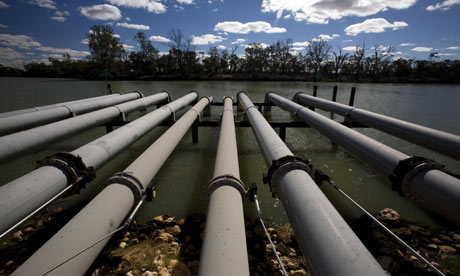A long-awaited $A10bn plan to safeguard the future of the sprawling but ailing Murray-Darling Basin, known as "Australia's food bowl", has dismayed both environmentalists and farmers.
The future of the basin has become an increasingly fractious issue in Australia, which experienced a decade of drought before heavy rain this year. Conservationists have clashed with farming and irrigation groups over the amount of water siphoned off to support agriculture and other industries in the Basin, which produces around 90% of Australia's fresh food supply.
The Murray Darling Basin Authority's draft plan, released on Monday, recommends that 2,750 gigalitres of water be returned to the system a year in order to replenish it. This figure, to be phased in over the next seven years, is well below the 4,000 gigalitres outlined in a preliminary guide last year, and some research has suggested up to 7,600 gigalitres may be required for the basin to recover.
One complicating factor is the basin's size – it spans an area equivalent to France and Spain combined, stretching from southern Queensland, through NSW and Victoria to the mouth of the Murray River in South Australia. In all, six separate state, territory and federal governments oversee the river system.
The decade-long drought, along with soaring demand for irrigated water within the basin's 2.1 million population, has put huge pressure on the Murray and Darling Rivers, as well as their tributaries. Less than half of the water that flows through the system reaches the sea.
The area's trees, including the red gum trees, frogs and waterbirds have suffered to varying degrees, while the draft plan acknowledges that half of the basin's native fish species have experienced "serious declines".
Salinity has also become a problem, with an estimated 2 million tonnes of salt accumulated within the river system. Environmentalists hoped that an increased water flow, achieved through mandatory "buy-backs" of water entitlements from irrigators, would wash away the salt.
However, the draft plan only proposes voluntary water buy-backs. Alarm has also been raised over the plan's doubling of permitted groundwater extraction and the lack of analysis over the future impact of climate change upon the basin.
"This draft plan fails the river, regional communities and our national interest, because it doesn't do enough to flush the salt out through the Murray mouth, revive dying wetlands and keep the country's lifeblood – the Murray-Darling – flowing," said Paul Sinclair, of the Australian Conservation Foundation. "There's no future, and there are no jobs, on a dead river. The basin plan must serve the national interest – not just the interests of big irrigation industries and their lobby groups and financial backers."
The Greens, part of Australia's minority federal government, also expressed dismay over the plan.
"Once again, the needs of the environment have been downplayed and the river is being sold out for a plan that is more about political appeasement rather than robust and long-term reform," said theh Greens senator Sarah Hanson-Young. "If the plan isn't improved, it will simply become a multibillion-dollar flop, and our river will not recover."
The plan also failed to appease the irrigation and farming lobby, which claimed that it will devastate large areas of Australia's rural economy. Last year, irate farmers and irrigators publicly burned copies of the preliminary plan.
Matt Linnegar, chief executive of the National Farmers Federation, said: "For the communities, the family farms and the local businesses across the basin, the result is more than disappointing – their very futures are on the line." . "The 2,750 gigalitres contained in the plan, plus the water historically set aside for the environment, means the environment has a significant amount of water at its disposal. The impact of this will be job losses, closure of family farms, hardships for regional communities and increases in fresh food prices."
The consultation period for the plan will last for 20 weeks. The South Australian premier, Jay Weatherill, has already raised the spectre of a legal challenge if the state doesn't receive more water from upstream states.

